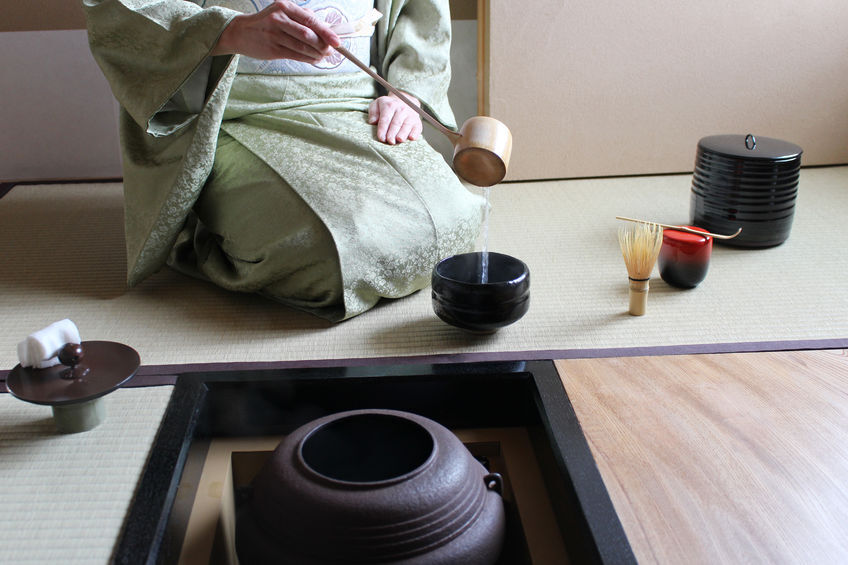- Business Solution
Reskilling Through Liberal Arts: The Basics of the Tea Ceremony for Businesspeople (1)

By: Yoh Otsuka (Senior Fellow & Senior Consultant, Intelligence Group, Nikkei Business Publications)
Companies are making progress in their efforts to "reskill," or help employees learn new skills. Some companies have begun to broaden their employees' perspectives by providing them with training in liberal arts fields in addition to specialized knowledge in management, information technology, and the like. This column will focus on the Japanese tea ceremony as a liberal art. The benefits of learning the tea ceremony include the acquisition of etiquette and a spirit of hospitality, the beautification of one's manners, and the appreciation of the seasons. Beyond this, however, mastering the tea ceremony is also useful in a variety of business situations. Warlords and modern business leaders have formed business networks through the tea ceremony. For globally active businesspeople, this column will provide an easy-to-understand explanation of this activity as a form of culture and introduce tips on how to apply it to business.
The tea ceremony is known in Japan as stemming from of "the way of tea," with the word "way" also being used for arts such as flower arrangement, calligraphy, and incense, as well as archery, kendo, and judo in sports. What they all have in common is that they teach kata (or "form") and etiquette, and through practice, those who engage in these "ways" are expected to cultivate spirit and build character.
People may consider the tea ceremony to be a hurdle to overcome because of the long hours spent sitting on tatami mats and the strict rules of etiquette. However, the tea ceremony is more than just a practice - it can be useful for business. Here are some examples.
Learning the tea ceremony can:
- ・improve work performance
- ・improve communication skills
- ・improve the ability to think and plan
- ・help people acquire leadership and risk management skills
- ・help communicate globally the spirit of the tea ceremony, which is linked to the SDGs and diversity
This column will introduce "tea ceremony tips for business" in turn. In this first installment of the series, we will explain the basics of the tea ceremony.
The Omotesenke, Urasenke, and Mushanokoji Senke schools of the tea ceremony are collectively called the Sansenke. The Sansenke was founded by the sons of Sen no Sotan, grandson of the tea master Sen no Rikyu. All of them have their headquarters in Kyoto.
In addition to the Sansenke, there are many other schools of tea ceremony, including the Edo Senke, Enshu, Horiuchi, and Yabuuchi schools. The utensils used and the manner of tea ceremony differ according to the school, but this article will not be limited to any particular school.
The Tea Ceremony is a Comfortable Fellowship between the Host and the Guest
The tea ceremony consists of the host (or hostess) and the guest or guests. The host invites the guests to a tea ceremony and entertains them with food, sweets, and matcha (powdered green tea).
The first step in the process of tea ceremony is to bring out the utensils, wipe them clean with a fukusa, and then serve tea to the guests. The tea ceremony can take as little as 15 minutes or as long as an hour or more. The amount of time and effort required to serve a single cup of tea to a guest is a characteristic of the tea ceremony.
The real appeal of the tea ceremony is the communication between the host and the guests that it makes possible.
When one joins a tea ceremony school under a tea master, he or she practices the flow of action and gestures event. In most cases, it is the host who performs the tea ceremony, but the guests also have their own special manners when receiving sweets and powdered green tea. Both the host and the guests have detailed rules for walking on the tatami mats and bowing, which are learned through practice.
Depending on the type of tea ceremony, it is possible to attend without any special knowledge, but if one has a little knowledge and understanding of this art, he or she will have a "common language" with the host, and thus be able to enjoy the depth of the tea ceremony.
Whisking Thin Tea and Drinking Thick Tea in Turns
There are two types of tea used in the tea ceremony: koicha (or thick tea) and usucha (or thin tea).
Even those who do not practice the tea ceremony may have had the experience of drinking usucha in a tearoom at a temple or a Japanese restaurant when traveling. Usucha is made by dissolving powdered matcha in hot water and whisking it with a chasen (or tea whisk). This is called "preparing the tea."
Koicha, on the other hand, is served with a larger amount of powdered matcha than usucha and mixed with a tea whisk in a process called "kneading the tea." The tea becomes thick to the touch like soup.
While a bowl of usucha is generally drunk by a single person, a bowl of koicha is usually passed around among several people (although Covid-19 has made the practice of drinking one bowl of koicha per person more common).
The tradition of passing the tea around is said to have been invented by Sen no Rikyu. During the Warring States period (1467-1568), it is said that the custom was intended to foster a sense of solidarity among warring feudal lords, who were all guests, by sharing a single cup of tea, or to prevent poisoning. Some believe that it was inspired by the passing around of wine at Christian masses.
Matching Utensils with the Theme of the Tea Ceremony
The tearoom in which a tea ceremony is held is furnished with a variety of utensils. The most important is a hanging scroll in the tokonoma (or alcove), which is also decorated with flowers. In addition, a kettle for boiling water, a mizusashi for holding water, and other utensils are necessary for serving tea.
The host of the ceremony brings to the tearoom a tea bowl, a tea caddy (or chaire) for thick tea or an usuki for thin tea, a chashaku to scoop powdered green tea, and a chasen (or tea whisk) to mix powdered green tea with hot water.
To hold a tea ceremony, the host first decides on a theme and then selects the right combination of utensils in accordance with the theme. For example, for a tea ceremony in September, the theme might be "moon viewing," so a hanging scroll with the Chinese character for "moon" would be displayed and a tea bowl with a picture of a rabbit would be used. In many cases, the utensils are named by their creators or inscriptions, and the exchange of questions and answers between the host and guests about these items is one of the features of a tea ceremony.
The theme of the tea ceremony is not only seasonal - it also varies from being a "celebration" to a "memorial service," and the assortment of utensils used changes accordingly.
Incidentally, the tea ceremony is deeply related to Zen, and words written by Zen monks are often used as hanging scrolls.
By looking at the hanging scrolls, one can learn how to read Zen words and calligraphy, and by looking at the tea utensils, one can gain knowledge about pottery and lacquerware. One can also experience the seasons through flowers and sweets. This is why the tea ceremony is called a comprehensive form of art.
The tea ceremony is basically performed sitting on the floor in a tatami-mat tearoom, but there is also a form of tea ceremony called ryurei, in which the participants sit on chairs with utensils laid out on a table.
This has been a brief description of the basics of the tea ceremony. Some may have had the experience of being asked questions about the tea ceremony when travelling abroad and not being able to answer them.
As a globally active businessperson, keep the above points in mind and one will not be at a loss for explanations.
In the next issue, we will introduce some examples of how the tea ceremony can be useful in business.
For further details, please contact:
Nikkei Business Publications, Inc.
NIKKEI BP

"Foresee the future, Unlock the insight" is the expression that describes our mission. As Japan's leading BtoB media service, we meet diverse business community needs in the three key categories of "management," "technology" and "lifestyle."
See More
